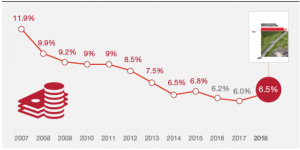PwC’s Health Research Institute (HRI) annually projects the growth of health insurance and more specifically, medical costs, in the employer insurance market for the coming year. They also identify the major factors expected to impact the trend. Moving into 2018, the healthcare industry seems to be settling into a “new trend” which is marked by more moderate fluctuations and single-digit medical cost trends
HRI projects 2018’s medical cost trend to be 6.5%—the first uptick in growth in three years.
What does this mean for employers still seeking to get the most for their insurance dollars and provide the best benefits for their employee population? In a labor market that is heating up and becoming more competitive, employers are looking for new cost containment strategies beyond shifting more costs to their employees.
Target Health and Wellness
Many employers are creating wellness programs and enlisting the employees in a partnership arrangement regrading practicing better health habits. Although hard numbers are difficult to come by, many employers believe they are creating a focus on wellness that will pay off at the bottom line. Employers are offering smoking cessation programs, health fairs populated by as many as 100 different vendors, offering everything from multi vitamins to massage, and healthy snacks, like fruit and nuts instead of candy, cupcakes and empty snacks.
Investigate provider arrangements
More employers are taking a harder look the health services they are providing and how those health services are being offered. Some are considering more restrictive arrangements like EPO’s (Exclusive Provider Organizations) where they can get better discounts by decreasing the size of the provider network. Other options include offering 2 tier plans where the employer pays a sizable percentage of the lower plan, but gives the employees an opportunity to “buy up” if they want to choose the more expensive plan.
Evaluate the value of drug spending
Employers are banding together to put pressure on drug companies to moderate price increases. Similar pressures were enacted in the early 1990s and significant decreases in the drug price growth rate.
We are already seeing some pharmaceutical companies take action, limiting price increases, offering cheaper generic alternatives and proactively addressing questions of value in the marketplace.
Even though health insurance price increases have slowed over the past three years, they still outpace inflation and employers need to continue to pursue alternatives that will lead to a healthier workforce and, ultimately, to lower health insurance costs for everyone.



